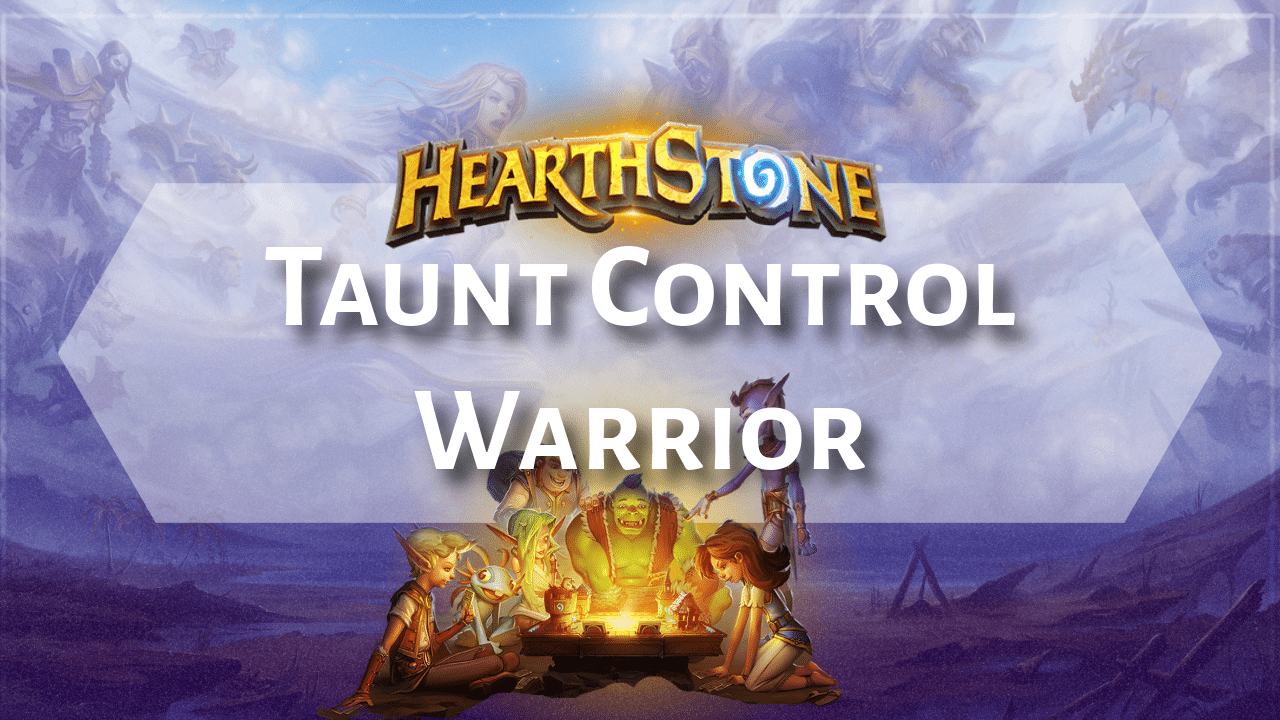
Hearthstone Taunt Control Warrior Introduction
HearthstoneTaunt Control Warrior is a resilient Hearthstone deck that combines the traditional control elements of the Warrior class with a proactive strategy centered around Taunt minions. The primary goal is to navigate the early and mid-game by utilizing efficient removal tools and sturdy Taunt creatures to establish board control and survive aggressive onslaughts. Often, these decks incorporate the Warrior Quest, Fire Plume’s Heart, which, upon completion, grants the player the powerful “Die, insects!” hero power, dealing 8 damage randomly each turn, providing significant late-game pressure. This blend of defensive capabilities and eventual offensive power makes HearthstoneTaunt Control Warrior a formidable archetype in the right meta.
The deck excels against aggressive and many midrange strategies due to its abundant Taunt minions that can stonewall early pressure and its suite of removal spells capable of dealing with early and mid-sized threats. The inherent ability of the Warrior class to gain armor further enhances its survivability, allowing it to outlast opponents in attrition-based matchups. The consistent damage from the Ragnaros hero power, once the quest is completed, provides a reliable win condition against slower decks.
However, the archetype can struggle against combo-oriented decks that aim for a one-turn kill or decks that generate overwhelming value over extended periods, particularly if the quest completion is delayed. Certain specific class matchups, such as Mage, have historically proven to be challenging. The core gameplan revolves around weathering the initial storm, efficiently clearing threats and establishing Taunt presence, completing the quest if the deck includes it, amassing armor to further solidify defenses, and ultimately leveraging the consistent damage from the upgraded hero power and any remaining threats to secure victory.
Hearthstone Taunt Control Warrior Core Cards and Decklists
The strength of HearthstoneTaunt Control Warrior lies in its carefully curated selection of cards that fulfill specific roles within the gameplan. Understanding the function of these core components is crucial for successful piloting.
At the heart of the deck are the Key Taunt Minions. Cards like Stonehill Defender are invaluable, offering not only a cheap Taunt body but also the opportunity to discover two additional Taunt minions, aiding in both quest completion and early-game defense. Alley Armorsmith provides crucial armor gain, especially in the face of aggressive boards, scaling its armor gain with the damage dealt by friendly minions. While some older iterations might have included Bloodhoof Brave as a mid-game Taunt, more recent lists often favor other options.
Tar Lord, frequently discovered through Stonehill Defender, serves as a formidable early-game wall that can significantly hinder aggressive strategies. Some variations, like the Dragon Taunt Warrior, might incorporate specific Taunt minions with tribal synergies, such as those discussed by Warshack, where dragons like Ysera, Awakened with its Taunt and Deathrattle effect are central to the strategy. Additionally, Direhorn Hatchling, as noted in some discussions, provides a Taunt minion and shuffles a powerful late-game threat into the deck, often synergizing with cards like The Curator.
To maintain control of the board, the deck relies on a suite of Key Control and Removal Cards. The iconic Fiery War Axe remains an essential early-game removal tool. Cheap area-of-effect (AoE) damage spells like Whirlwind and minions such as Ravaging Ghoul are often paired with Sleep with the Fishes for powerful board clears that can efficiently deal with early to mid-game boards. Single-target removal comes in the form of Execute, which can dispatch damaged minions efficiently. For dealing with more resilient threats, Brawl offers a board reset, leaving only one minion standing. In decks that heavily emphasize armor gain, Shield Slam provides powerful single-target removal that scales with the Warrior’s armor total.
For many HearthstoneTaunt Control Warrior builds, the quest card, Fire Plume’s Heart, is a central win condition. Completing the quest by playing a certain number of Taunt minions rewards the player with the “Die, insects!” hero power, which deals 8 random damage each turn, providing consistent late-game pressure that can overwhelm opponents.
Survival is further enhanced through dedicated Armor Gain cards. Shield Block provides a burst of armor along with valuable card draw. As mentioned earlier, Armorsmith generates incremental armor based on friendly minion combat. Of course, the basic Warrior hero power also contributes 2 armor per turn.
To ensure a steady flow of resources, Card Draw is essential. Minions like Acolyte of Pain, which draw cards when damaged, provide consistent draw potential. Shield Block, in addition to armor, also draws a card. In some list variations, The Curator serves as a valuable card draw engine, pulling out a Beast (like Direhorn Hatchling) and a Dragon, if included in the deck. The “All You Can Eat” card mentioned by Warshack in their Dragon Taunt Warrior also serves a card draw function, drawing three minions of different types.
Finally, Tech Cards can be included to address specific meta strategies. Dirty Rat, as highlighted in several sources, can be a powerful tool to disrupt opponent’s combos or remove key minions from their hand, although its usage requires careful consideration of the matchup and potential downsides.
Examining example decklists from the sources provides further insight into card choices and variations. Bell’s Taunt Warrior list, discussed on Reddit, emphasized a strong control package with multiple copies of Whirlwind, Sleep with the Fishes, and Slam, alongside crucial survivability tools like Armorsmith and the core Taunt minions and the quest. Obivankenobi’s Taunt Control Warrior list from April 2025, featured on Hearthstone Top Decks, showcases a more modern approach, incorporating cards like “Concussive Shells,” “Safety Goggles,” and “Hydration Station,” suggesting an evolution of the archetype into a more general Control Warrior shell with Taunt elements.
Xerneth7’s OTK Control Taunt Warrior in Wild, from February 2023 on HearthPwn, took a completely different approach, focusing on cards like “Last Stand” and “Rivendare, Warrider” to achieve a combo-oriented finish, highlighting the diverse possibilities within the Warrior class. Warshack’s Dragon Taunt Warrior build, utilizing “Ysera, Awakened” and cards like “Succumb to Madness” and “Clutch of Corruption,” demonstrates a synergistic approach centered around dragon recursion. The YouTube videos from Christian Hearthstone often feature Control Warrior lists that may or may not heavily emphasize Taunt minions, showcasing a broader spectrum of Warrior strategies being explored.
Hearthstone Taunt Control Warrior General Gameplay Strategy
Mastering HearthstoneTaunt Control Warrior requires a nuanced understanding of how to approach different phases of the game and manage resources effectively.
In the Early Game (Turns 1-3), the primary focus is on establishing early board control and initiating quest progression if the quest is included. Fiery War Axe is instrumental in removing early threats from aggressive opponents. Playing early Taunt minions like Stonehill Defender not only provides immediate board presence but also progresses the quest count and offers the potential for discovering further defensive options. Against swarm-style aggressive decks, utilizing early AoE like Whirlwind or Ravaging Ghoul can be crucial for preventing the opponent from snowballing their board advantage.
Moving into the Mid Game (Turns 4-7), the strategy involves continuing to deploy Taunt minions to protect your life total and contest the board against midrange strategies. Removal spells like Execute and Sleep with the Fishes become essential for dealing with larger, more resilient threats that your opponent might deploy. Maintaining a steady flow of cards is vital, making cards like Acolyte of Pain and Shield Block key for replenishing your hand. The goal during this phase is often to complete the Fire Plume’s Heart quest if it’s part of your deck composition, as the resulting hero power significantly shifts the late-game dynamic.
As the game transitions into the Late Game (Turns 8+), the strategy pivots towards capitalizing on the completed quest’s hero power and utilizing high-value minions to close out the game. The “Die, insects!” hero power provides consistent 8 damage each turn, applying significant pressure that many slower decks struggle to answer. Board clears like Brawl remain important for dealing with late-game threats that might overwhelm your Taunt defenses. Amassing additional armor through your hero power and other armor gain cards further increases your survivability against potential burst damage and allows you to outlast opponents in prolonged attrition battles.
Throughout all phases of the game, Resource Management is paramount. Removal spells must be used judiciously, targeting key threats rather than wasting them on less impactful minions. Balancing the need to play Taunt minions for quest completion and board presence with the urgency of gaining armor to survive requires careful evaluation of each matchup. Ensuring a consistent supply of cards through effective card draw is crucial for having the necessary answers and threats available as the game progresses.
Hearthstone Taunt Control Warrior Mulligan Guide
The mulligan phase, the initial card draw at the start of the game, is critical for setting up your early game and influencing your chances of success.
Keep Almost Always:
If you’re playing the quest version, Fire Plume’s Heart is often a strong keep to start progressing early and maximize its impact, though some suggest reconsidering this against hyper-aggressive decks where survival is the immediate priority. Fiery War Axe is almost always a keep thanks to its efficiency in handling early threats across many matchups. Ravaging Ghoul is particularly effective against aggressive decks that swarm the board with low-health minions, offering valuable early AoE. Stonehill Defender also makes a solid early-game play, providing a Taunt body for defense and the chance to discover additional Taunt minions to aid in both survival and quest progression.
Conditional Keeps (if your hand is already strong):
Sleep with the Fishes can be a strong early keep if you already have an activator like Whirlwind or Ravaging Ghoul in hand, offering an efficient board clear against minion-heavy strategies. Dirty Rat is another situational mulligan option, especially in matchups where disrupting a key combo piece or early quest minion is crucial—it’s considered a high-risk, high-reward play, particularly effective against Rogue.
Mulliganing Against Specific Classes:
Mulligans can vary greatly depending on the class you’re facing. Against Warrior, it’s tricky due to the possibility of encountering either Pirate Warrior or Taunt Warrior; keeping the Quest, Dirty Rat, and early Taunts is advisable in a potential mirror, but against Pirate Warrior, it’s often better to ditch the Quest and prioritize early removal like Fiery War Axe—watching the opponent’s mulligan can sometimes offer hints. Against Rogue, particularly Quest Rogue, aggressively mulliganing for Dirty Rat is highly recommended, even at the cost of discarding the Quest, with early removal and Taunts also being valuable.
Facing Hunter, especially aggressive or midrange variants, calls for keeping Fiery War Axe, Ravaging Ghoul, and Stonehill Defender to contest the early board, and the Quest is usually tossed to focus on surviving the pressure. For Mage, typically a burn-heavy strategy, early-game tools like Fiery War Axe, Ravaging Ghoul, and Stonehill Defender are crucial; while some guides suggest keeping the Quest, newer approaches favor dropping it to improve consistency in early defenses against aggressive Mage decks.
The decision of whether to keep the quest in the mulligan often depends on the specific matchup and the rest of your starting hand. Against slower, more controlling opponents, keeping the quest is usually beneficial. However, against aggressive decks where early survival is paramount, prioritizing early removal and Taunt minions often takes precedence.
Hearthstone Taunt Control Warrior Matchup Analysis
Understanding how HearthstoneTaunt Control Warrior fares against different archetypes is crucial for adapting your strategy and card choices. Based on the information available, here’s a summary of common matchups:Aggro matchups like Hunter and Pirate Warrior are generally favorable if you can draw early removal and Taunt minions, with board control and survival being key—armor gain from cards like Alley Armorsmith is especially valuable. Against midrange decks, success often depends on efficiently removing threats and establishing board presence with Taunts, while practicing value trading and avoiding overextension.
Control matchups, such as the Taunt Warrior mirror, typically hinge on who completes their quest first and can generate more armor and long-term value, with tech cards like Dirty Rat playing a disruptive role. Mage, especially aggressive burn variants, can be challenging, though Alley Armorsmith helps by providing crucial sustain. Rogue, particularly Quest Rogue, is also difficult and requires disrupting their quest with Dirty Rat, alongside strong early board presence and removal. Shaman matchups tend to be attrition-based, demanding careful board control and resource management. Priest can be problematic, especially archetypes that use silence or generate large single threats, as they can bypass Taunt minions or outscale your removal tools.
Hearthstone Taunt Control Warrior Advanced Tips and Considerations
To truly master HearthstoneTaunt Control Warrior, consider these advanced tips and nuances:
Armor is your ally—consistently using your hero power and leveraging cards like Shield Block and Armorsmith to build a significant armor buffer is crucial for survival, especially against aggressive strategies. High armor totals also enhance the effectiveness of Shield Slam. The strategic use of Dirty Rat is vital; deploy it thoughtfully based on the opponent’s class, potential combo pieces, and your ability to handle whatever minion is pulled. It’s most effective when paired with removal or a strong board presence.
Understanding card synergies is key—for example, combining Whirlwind or Ravaging Ghoul with Sleep with the Fishes enables efficient AoE removal. If your deck includes Fire Plume’s Heart, focus on playing Taunt minions to complete the quest quickly, as the upgraded hero power offers a powerful late-game advantage. Be ready to adapt your list based on the current meta; if combo decks are prevalent, tech cards like Dirty Rat may be necessary, while aggressive metas may call for more early-game removal or Taunt options.
Some players, like Sjow in his Reddit-shared list, have even experimented with omitting classic Control Warrior tools like Shield Slam to better suit evolving conditions. Finally, recognize that Taunt Warrior can take many forms—Dragon Taunt Warrior, highlighted by Warshack, leans into dragon synergies and recursion, while OTK Taunt Warrior showcases the potential for burst damage finishes. Exploring these variations can expand your understanding of the archetype’s versatility.
By understanding the core principles, card choices, and strategic nuances outlined in this guide, you will be well-equipped to pilot HearthstoneTaunt Control Warrior effectively and build your own stalwart defenses on the Hearthstone ladder. Remember that practice and adaptation are key to mastering any deck, so be sure to play games, analyze your matchups, and refine your strategy as you gain experience.













